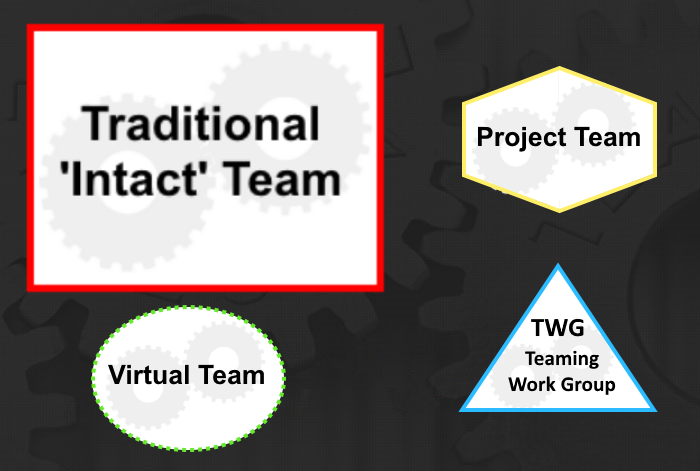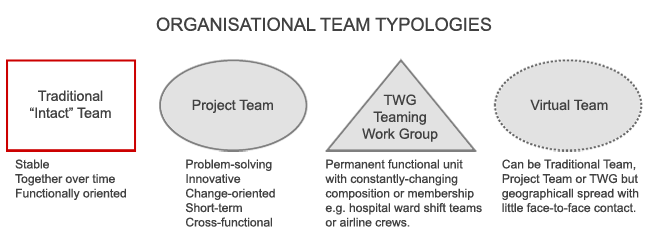ODDBLOG

November 28, 2014
Team Types and their Characteristics: The Traditional 'Intact' Team
There are four principle team types to be found in most organisations. These are ‘Traditional “Intact” Teams’, ‘Project Teams’, ‘Teaming Work Groups’ and ‘Virtual Teams’. While these team types share many characteristics and challenges, each is unique in terms of how it interacts with its environment.

Developing a team and maximising its effectiveness requires an understanding and recognition of the different team types and the particular characteristics and challenges that differentiate one from the other. In this article—the first in a series of four on Team Types—we explore aspects of the Traditional ‘Intact’ Team and identify ways to maximise the potential of such a team.
The Traditional Team: Functional and Familiar
This is the team type we are most familiar with as in ‘The Finance Team’, ‘The HR Team’, ‘The Production Team’ or ‘The Sales Team’. This is a functional team in which specialists work together and share a common technical vocabulary and a common understanding of their team’s processes and goals. Traditional Teams are in some cases departments in their entirety and in others a group of teams making up a department.
Leadership is predetermined by the hierarchical structure of the organisation and is undertaken by the most senior person in that team.
The team is often inherited by its leader and new members are recruited to the team based on their technical skills and not necessarily on those personal attributes that determine how they are most likely to operate in a team.
The traditional team is relatively stable over time. It exists year to year, generally experiencing a low rate of attrition with leavers replaced as required.
The team is mostly engaged in what are described as routine tasks i.e. tasks that are repeated continually and based on team members’ specialisations.
Occasionally new projects and tasks are introduced that may involve a single member of the team, a few members of the team or the entire team. These new projects and tasks tend to relate to the introduction of new methods of working, new technologies or new roles and responsibilities for the team as a whole that once introduced, become part of the team’s routine.
The Strengths of Traditional Teams
- The traditional team structure promotes in-depth competence. This is both supported and highlighted in a common understanding of team language, processes and goals.
- There is freedom for team members to specialise and excel in their respective areas of expertise while others—the management and administrative specialists—can specialise in the task of co-ordination.
- There is a stability and security for team members. Change is relatively and comparably slower and quick responses to change are not always essential.
The Challenges for Traditional Teams
- With leadership determined by seniority and via the organisational hierarchy, the most appropriate team leader may not be in place:
- Promotions tend to be based on technical competence and not necessarily on people management skills.
- It is a common assumption that an individual reaching a certain level in the hierarchy has the skills required to lead a team.
- Technical leadership and people management skills should not be confused with team leadership skills (which few of us naturally possess). Team leadership is a skill in its own right that needs to be developed
- People who share the same specialisation and who operate functionally tend to perceive the world through their specific lens. Their functional role conditions how they perceive time, how they prioritise tasks and how they identify and solve problems.
- Functional teams or traditional work teams are part of complex integrated structure that is the functional hierarchy. The decision-making process is slower in this type of team and organisation with a need for most information to go ‘up the line’. This can result in ‘bottlenecking’ and decisions piling up at the top.
- Few members of the team have ‘the big picture’ as they are focused on their own specialisation.
- The team becomes focused—and correctly so—on routine tasks but can find it difficult to shift direction quickly when required.
- Routine can lead to complacency with repetition and time pressure often preventing the team from considering its modus operandi. Innovation can be hampered in this situation.
- Team meetings are invariably about operational issues with individual team members reporting to the leader on their area of expertise. Indeed, the team meeting can appear to the outsider as a series of one-to-ones between a team member and the leader—with an audience present!
The Imperatives for Traditional Teams
To maximise the potential of this type of team the organisation, through the individual team leaders, should provide ongoing support while ensuring effective performance monitoring, planning and evaluation.
It must be noted that the traditional team [functional team or departmental team] is comprised of individuals with specific job or organisational roles. Much of team members’ time is spent working on an individual basis. Not every task and action is team based. It is only in the areas of task and role interdependency that the application of team skills matters.
Finally…
Traditional ‘Intact’ Teams are the most common type of team and evolve from the way we design organisations.
Because they are so common and delineated by functional specialisation, they are often overlooked in terms of their team development needs. Individual skills development takes place, but seldom in the context of the overall team requirement or in the context of an overall organisational team strategy.
It is regularly assumed that these teams can operate without any support. Yet support is crucial when such teams form, in many cases, the ‘core’ of an organisation. Maximising effectiveness at the core through an organisational team strategy provides a very strong basis for ensuring effective organisational performance overall.
Maybe the Traditional Team deserves more attention than it actually gets!
